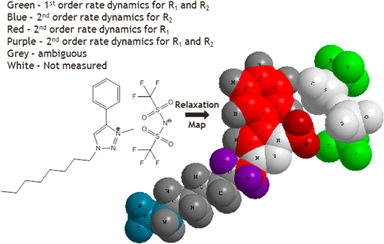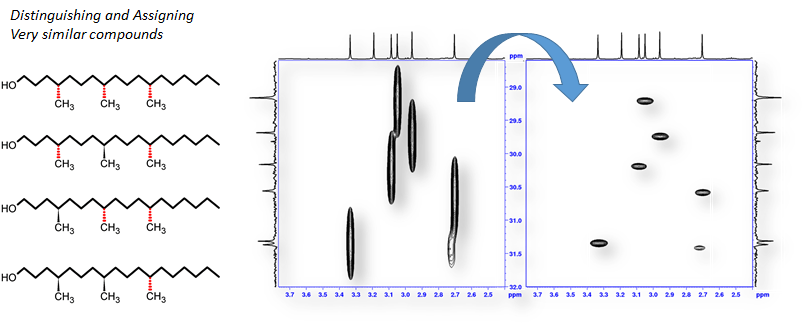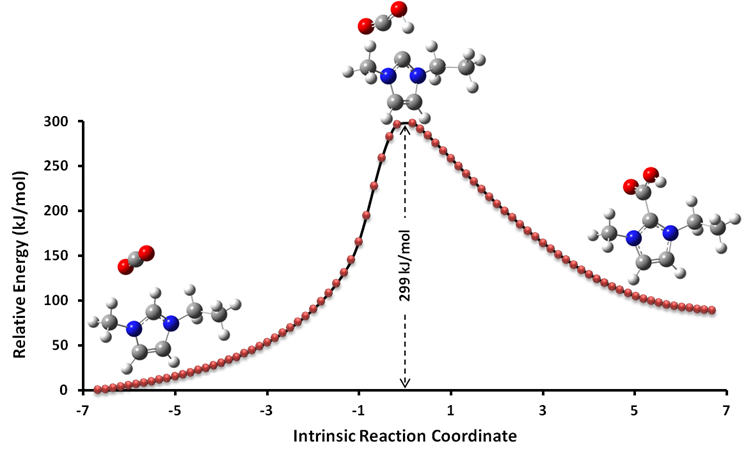NMR Spectroscopy is an exceptionally powerful analytical tool that has found applications in inter-disciplinary areas of science. Beyond routine characterization, vast array of advanced NMR techniques provide deep insights into structure and dynamics of materials. Our research focuses on the applications of NMR spectroscopy and computational tools to variety of problems in various areas of scientific research, some of which are briefly described below.
Structure and Dynamics of Ionic Liquids
 Multitude of advanced NMR experiments such as Pulse Field Gradient, Relaxation, NOE techniques and other Multi-Nuclear NMR experiments offer excellent opportunities to probe structure and dynamics of ionic liquids.
Multitude of advanced NMR experiments such as Pulse Field Gradient, Relaxation, NOE techniques and other Multi-Nuclear NMR experiments offer excellent opportunities to probe structure and dynamics of ionic liquids.
RSC Advances (2014), 4, 12748–12755.
Physical Chemistry Chemical Physics (2014), 16, 8078-8085.
The Journal of Physical Chemistry B (2013) 117(14), 3877-3883.
Physical Chemistry Chemical Physics (2013),15, 3264-3272.
Physical Chemistry Chemical Physics (2012), 14(45), 15897-15908.
Green Chemistry (2011), 13(12), 3345-3349.
Transport Properties of Molecules
 Self-diffusion of molecules provide information about their translational dynamics, solvation, aggregation and even conformation. In ionic liquids, diffusion is the process of transport of charges via cations or anions, which when combined with impedance analysis provide insights into ion-pair dynamics.
Self-diffusion of molecules provide information about their translational dynamics, solvation, aggregation and even conformation. In ionic liquids, diffusion is the process of transport of charges via cations or anions, which when combined with impedance analysis provide insights into ion-pair dynamics.
Magnetic Resonance in Chemistry (2015), 53(3), 200-202.
Chemical Physics (2014), 440, 87-93.
The Journal of Physical Chemistry B (2014), 118(48), 13870-13881.
The Journal of Physical Chemistry B (2014), 118(47), 13609-13620.
The Journal of Physical Chemistry B (2014), 118(36), 10565-10575.
Ultra High Resolution NMR for Small Molecule Structural Analysis
 Spectral resolution is the key for thorough characterization of materials in NMR spectroscopy. It is possible to obtain superior resolution beyond what is obtained via routine techniques in a couple of ways. Novel experiments dedicated for obtaining ultra-high resolution could be followed. Improved resolution could also be achieved by simply fine tuning often overlooked NMR parameters.
Spectral resolution is the key for thorough characterization of materials in NMR spectroscopy. It is possible to obtain superior resolution beyond what is obtained via routine techniques in a couple of ways. Novel experiments dedicated for obtaining ultra-high resolution could be followed. Improved resolution could also be achieved by simply fine tuning often overlooked NMR parameters.
Journal of Organic Chemistry (2014), 79(16), 7477-7490.
Journal of Organic Chemistry (2013), 78(10), 4913-4918.
Journal of the American Chemical Society (2013), 135(4), 1577-1584.
Journal of the American Chemical Society (2011), 133(8), 2427-2436.
Dynamic NMR - Thermodynamics of Bond Rotation
 Dynamic NMR spectroscopy offers a simple means to determine bond rotation rates, barrier to the rotation and thermodynamic parameters (via Eyring plots). It is important to remember that sample temperature, solvent and also magnetic field strengths govern the onset/offset of coalescence.
Dynamic NMR spectroscopy offers a simple means to determine bond rotation rates, barrier to the rotation and thermodynamic parameters (via Eyring plots). It is important to remember that sample temperature, solvent and also magnetic field strengths govern the onset/offset of coalescence.
Journal of Organic Chemistry (2015), 80(9), 4465-4469.
Journal of Organic Chemistry (2009), 74(15), 5481-5485.
Journal of Organic Chemistry (2009), 74(11), 4262-4266.
Computational Chemistry
 Computational chemistry is a complementary tool for experimental investigations. We use computational calculations along with experimental techniques to understand molecular interactions in ionic liquids. We also use them to investigate reaction mechanisms, especially the mechanism of CO2 capture in ionic liquids.
Computational chemistry is a complementary tool for experimental investigations. We use computational calculations along with experimental techniques to understand molecular interactions in ionic liquids. We also use them to investigate reaction mechanisms, especially the mechanism of CO2 capture in ionic liquids.
Physical Chemistry Chemical Physics (2016), 18, 1911–1917.
Ionics (2015), 21(6), 1605-1613.
Journal of Organometallic Chemistry (2013), 741-742, 15–19.
Journal of Molecular Structure (2013), 1038, 12–18.
Journal of Molecular Liquids (2012), 175, 141-147.
 Multitude of advanced NMR experiments such as Pulse Field Gradient, Relaxation, NOE techniques and other Multi-Nuclear NMR experiments offer excellent opportunities to probe structure and dynamics of ionic liquids.
Multitude of advanced NMR experiments such as Pulse Field Gradient, Relaxation, NOE techniques and other Multi-Nuclear NMR experiments offer excellent opportunities to probe structure and dynamics of ionic liquids.
 Self-diffusion of molecules provide information about their translational dynamics, solvation, aggregation and even conformation. In ionic liquids, diffusion is the process of transport of charges via cations or anions, which when combined with impedance analysis provide insights into ion-pair dynamics.
Self-diffusion of molecules provide information about their translational dynamics, solvation, aggregation and even conformation. In ionic liquids, diffusion is the process of transport of charges via cations or anions, which when combined with impedance analysis provide insights into ion-pair dynamics.
 Spectral resolution is the key for thorough characterization of materials in NMR spectroscopy. It is possible to obtain superior resolution beyond what is obtained via routine techniques in a couple of ways. Novel experiments dedicated for obtaining ultra-high resolution could be followed. Improved resolution could also be achieved by simply fine tuning often overlooked NMR parameters.
Spectral resolution is the key for thorough characterization of materials in NMR spectroscopy. It is possible to obtain superior resolution beyond what is obtained via routine techniques in a couple of ways. Novel experiments dedicated for obtaining ultra-high resolution could be followed. Improved resolution could also be achieved by simply fine tuning often overlooked NMR parameters.
 Dynamic NMR spectroscopy offers a simple means to determine bond rotation rates, barrier to the rotation and thermodynamic parameters (via Eyring plots). It is important to remember that sample temperature, solvent and also magnetic field strengths govern the onset/offset of coalescence.
Dynamic NMR spectroscopy offers a simple means to determine bond rotation rates, barrier to the rotation and thermodynamic parameters (via Eyring plots). It is important to remember that sample temperature, solvent and also magnetic field strengths govern the onset/offset of coalescence.
 Computational chemistry is a complementary tool for experimental investigations. We use computational calculations along with experimental techniques to understand molecular interactions in ionic liquids. We also use them to investigate reaction mechanisms, especially the mechanism of CO2 capture in ionic liquids.
Computational chemistry is a complementary tool for experimental investigations. We use computational calculations along with experimental techniques to understand molecular interactions in ionic liquids. We also use them to investigate reaction mechanisms, especially the mechanism of CO2 capture in ionic liquids.